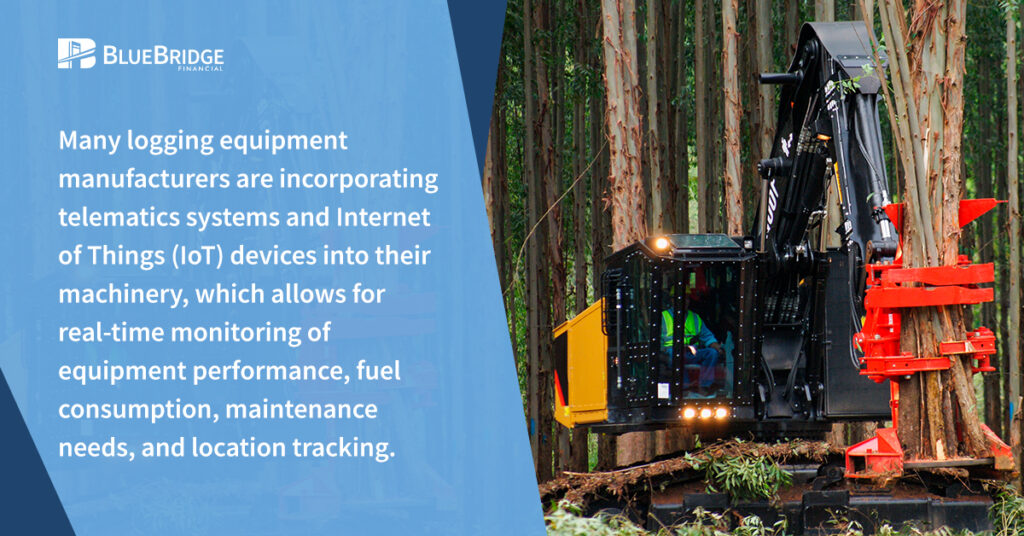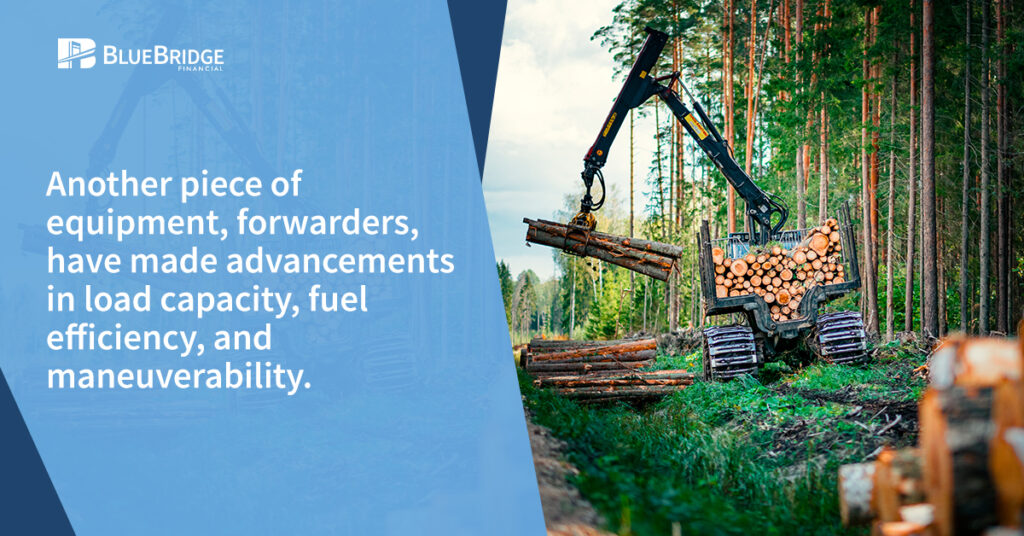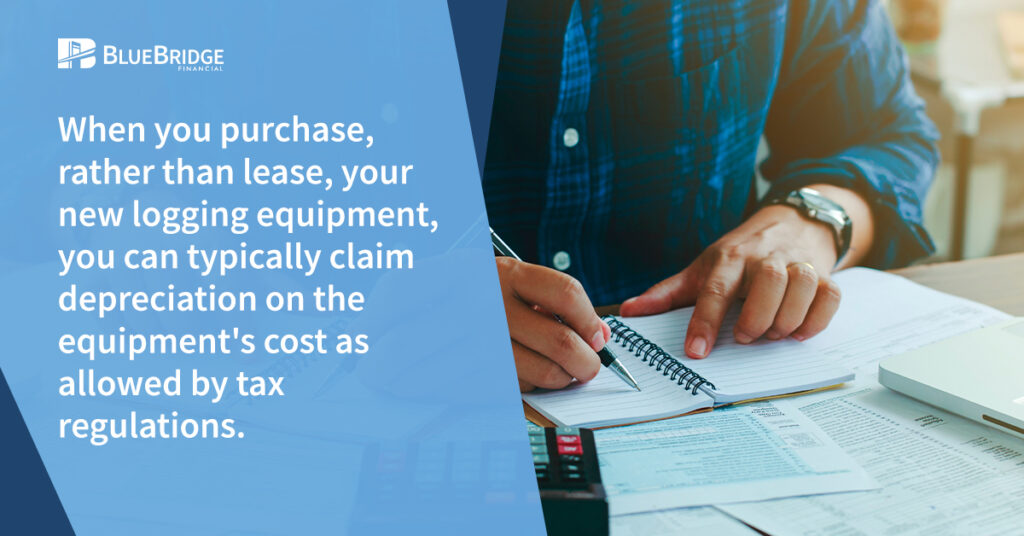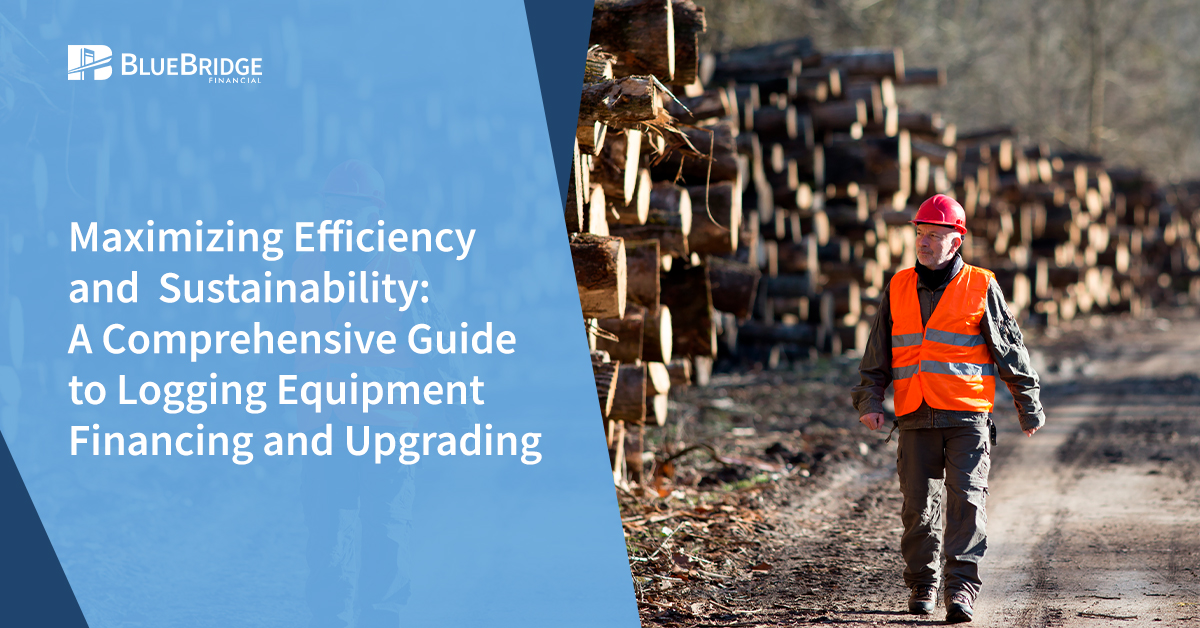Maximizing Efficiency and Sustainability: A Comprehensive Guide to Logging Equipment Financing and Upgrading
Boost Logging Efficiency and Go Green with the Right Equipment Strategy
To run your logging business efficiently and sustainably, you need to invest in the latest equipment and technology. In this article, we’ll cover the evolution of logging equipment over the years, look at current trends, and help you evaluate whether it’s time to upgrade your equipment. Ready to invest in your business? Contact us to learn more about our flexible, competitive options for financing equipment purchases.
Why Upgrade Your Logging Equipment?
Modern logging equipment makes the management, harvesting, and processing of trees more efficient and sustainable. Here are the top three reasons to upgrade your logging business equipment.
Technological Advancements
Automation and Robotics:
Can perform repetitive tasks with more precision. A safer option–reduces the risk of accidents and increases productivity.
GPS/GIS Technologies:
Enables precise mapping and tracking of resources, helping you plan harvest strategies and reducing environmental impact.
Harvesting Heads with Sensors:
Enables on-the-spot decisions. Helps reduce waste and increase efficiency.

Efficiency in Operations
- Realize cost savings through the purchase of more efficient logging equipment.
- Increase the productivity of your crew through better cutting mechanisms and automations.
- Reduce downtime from broken down equipment. The newer models are usually more reliable and require less maintenance.
- Improve fuel efficiency by purchasing the latest, most fuel efficient equipment.
- Many time-saving features of new equipment also contribute to better safety for logging crews. For example, loggers can stay on the ground and delimb and buck felled trees remotely.
Environmental and Regulatory Compliance
- More modern equipment is designed with a focus on reducing environmental damage.
- Lighter machinery reduces logging’s ecological footprint.
- Today’s logging equipment produces lower emissions, noise and dust reduction, less soil compaction, and improved fuel efficiency.
- Compliance with emission standards
- Upgrading your logging equipment can put you in compliance with emission standards and help you qualify for certifications such as the forest stewardship council certification.
How Has Logging Equipment Evolved?
Logging equipment has evolved over time. Here are the latest developments in skidders, harvesters, and woodchippers.
Skidders
Today’s skidders have more engine efficiency and reduced emissions. New skidder engines can meet stricter environmental regulations, such as Tier 4 standards. They are also more sophisticated with better ergonomics, operator comfort, and Advanced Drive Systems. The technological integration with GPS and onboard diagnostics is also better in modern skidders.
Harvesters
Newer harvesters offer increased automation and precision, greater fuel efficiency, and improved durability and maintenance. You will also find enhanced operator comfort and safety in a new harvester. They are more adaptable to various forest conditions, such as sloped ground.
Woodchippers
Utilize the entire tree with a chipper. You may be able to add a new revenue stream to your logging business by selling wood chips for renewable fuel. Today’s tree chippers offer increased power and efficiency, while still being more mobile and easier to transport than previous models. They are also more environmentally friendly, with reduced emissions, and last-longing with enhanced durability and reliability.

Current Trends In The Logging Industry
From climate and environmental changes, to technology, demand for construction, and the labor market, current trends in the logging industry present both challenges and opportunities to business owners.
Emerging Technologies
Technology continues to advance with precision forestry features like GIS, GPS, and remote sensing. You can leverage data and analytics from modern logging equipment to improve efficiency in your business.
Sustainability Trends
Sustainability is a concern for many consumers and businesses. Publicizing your sustainable logging practices can give you a competitive edge. For example, you could:
- Use timber that’s been certified by organizations like the Forest Stewardship Council and the Programme for the Endorsement of Forest Certification.
- Add urban logging and salvage logging to your service offerings.
- Add eco-friendly equipment to your fleet.
- Climate-Smart Forestry
- Agroforestry and mixed use land
Equipment Financing Options
Purchasing new equipment can be a major investment in your logging business. With the right financing, you can preserve your cash on hand while finding a monthly payment that fits your budget.
Leasing vs Buying
Leasing equipment is a contractual agreement to use the equipment for a specific period of time in exchange for a certain monthly payment amount. On the other hand, purchasing equipment means you will own it outright after paying off the equipment financing. Learn about the pros and cons of each option below.
Leasing Pros:
- Reduced initial investment of cash
- Flexibility to decide whether you want to keep the equipment or not
- Cash flow management
Leasing Cons:
- Higher long-term cost
- Not building equity
- Contractual obligations
- Possible penalties for early termination or the condition of equipment
Buying and Financing Pros:
- Ownership and asset accumulation
- Long-term cost savings
- Tax benefits
- No usage restrictions
- Freedom to modify and customize equipment as needed
Buying and Financing Cons:
- Higher initial upfront cost
- Value will depreciate over time
- Maintenance and repair costs

Federal Grants and Financing Programs
In addition to the more traditional routes of leasing and financing, explore these government-backed loan and grant programs for logging businesses.
- The U.S. Small Business Administration (SBA) offers several loan programs for small businesses, including the 7(a) loan program.
- The U.S. Department of Agriculture’s (USDA) Rural Development Business Programs help meet lending needs in rural and other under-served areas.
- The USDA Forest Service awards grants to businesses who match the agency’s mission of caring for the land and service people. Wood Innovations and Community Wood grants are also available for innovation in the wood products economy.
Tips For A Successful Equipment Financing Application
At Blue Bridge Financial, we offer financing options for buying equipment, focusing on helping you invest back into your business. Check out our recent blog post on “Common Financing Roadblocks: How To Prepare For And Overcome These 5 Obstacles” for tips on successfully completing your equipment financing application.
Preparing for Future Challenges
- Embrace sustainable practices
- Invest in advanced technology
- Diversify Operations
- Develop your workforce
- Enhance regulatory compliance
About Blue Bridge Financial
Founded in 2009, Blue Bridge Financial is a specialty equipment finance firm serving Logging and Forestry businesses and other industries. Our Equipment Finance Agreements offer flexible and competitive financing for the essential equipment you need to grow your logging and forestry business. Let us help you prepare for future challenges by embracing sustainable practices and investing in advanced technology. Start our easy application today or contact us with questions.
Any Questions? We'd Love to Talk:
About the Author
Nick Devernis is the Vice President of Business Development with expertise in credit analysis and equipment financing. With over 6 years in equipment financing, he offers a wealth of knowledge to readers of Blue Bridge Financial’s blog. He currently oversees the California office and leads the Sales and Marketing departments. Nick’s role as Vice President of Business Development involves management of the sales team, relationship management, and developing strategic partnerships to drive inbound and outbound originations.p> LinkedIn Profile






